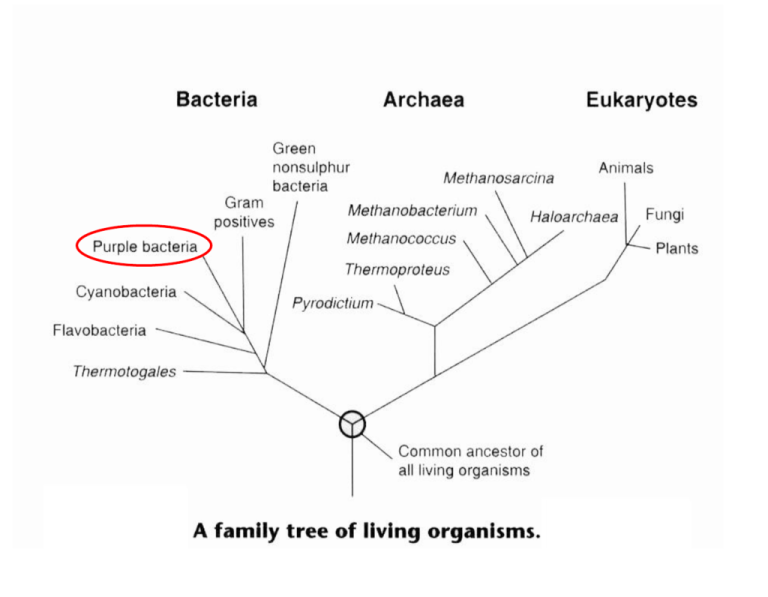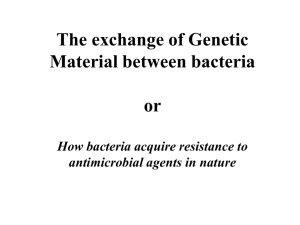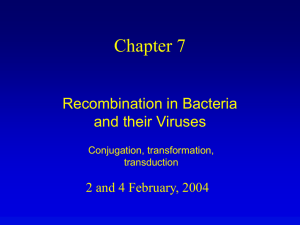Bacteria Predominate
advertisement

Bacteria Predominate Bacteria Do Almost Everything • Metabolism; • 10,000+ “Species”, – Mycoplasma genetalium • 200 nm – Thiomargarista namibiensis • 750 mm – soil, water, air, symbionts, – have adapted to aquatic and terrestrial extremes, • 100 grams/person, – 1014 bacteria. – Phototrophs, – Chemotrophs, • Biochemistry; – ‘fix’ or synthesize a huge range of molecules, – break down almost anything, – adapt to just about anything. • Molecular Biology; – – – – – Clone, Gene therapy, Eugenics, Biotechnology, Etc. Bacterial Chromosome ...a circular molecule of double helical DNA, – 4 - 5 Mb long in most species studied, – 1.6 mm long if broken and stretched out. • Inside the cell, the circular chromosome is condensed by supercoiling and looping into a densely packed body termed the nucleoid. Extra Chromosomal DNA • Plasmids: circular double stranded DNA molecule that replicates independently, – containing one or more (nonessential) genes, smaller than the bacterial chromosome, – may carries genes for pathogenicity, – may carry genes for adaptation to the environment, including drug resistance genes, – 1000’s of base pairs long. Bacterial Model Organism Escherichia coli = E. coli • Enteric bacteria: inhabits intestinal tracts, – generally non-pathogenic, – grows in liquid, – grows in air, • E. coli has all the enzymes it needs for amino-acid and nucleotide biosynthesis, – can grow on minimal media (carbon source and inorganic salts), • Divides about every hour on minimal media, – up to 24 generations a day, Growth Equals Cell Division DNA Replication Binary Fission Bacterial mitosis. Why don’t bacteria do meiosis? The (Awesome) Power of Bacterial Genetics ... is the potential for studying rare events. Liquid Cultures, • 109cells/microliter, Colonies on Agar, • 107+ cells/colony Counting Bacteria 10-3 10-4 10-5 (Serial) Dilution is the Solution Model Model Organism • Ease of cultivation, • Rapid Reproduction, • Small size, • Fecund (large brood size), • Mutants are available, stable and easy to identify? • Literature? • PubMed Listings: Eubacteria: 612,471, Archaebacteria: 9,420 Bacteria Phenotypes • colony morphology, – large, small, shiny, dull, round or irregular, – resistance to bactericidal agents, • auxitrophs, – unable to synthesize raw materials from minimal media, • cells unable to break down complex molecules, • essential genes, usually studied as conditional mutants. Bacteria Phenotypes • colony “morphology”, – large, small, shiny, dull, round or irregular, – resistance to bactericidal agents, – vital dyes, • auxitrophs, – unable to synthesize or use raw materials from the growth media. Prototroph …a cell that is capable of growing on a defined, minimal media, – can synthesize all essential organic compounds, – usually considered the ‘wild-type’ strain. Auxotrophs …a cell that requires a substance for growth that can be synthesized by a wild-type cell, hisleuargbio- ...can’t synthesize histidine (his+ = wt) ...can’t synthesize leucine (leu+ = wt) ...can’t synthesize arginine (his+ = wt) ...can’t synthesize biotin (bio+ = wt) Bacterial Nomenclature • genes not specifically referred to are considered wildtype, – Strain A: met bio (require methionine and biotin) – Strain B: thr leu thi • bacteriacide resistance is a gain of function, – Strain C: strA (can grow in the presence of strptomycin). Conjugation ...temporary fusion of two single-celled organisms for the transfer of genetic material, …the transfer of genetic material is unidirectional. + - F Cells F Cells (F for Fertility) (F for Fertility) … F+ cells donate genetic material. … F- cells receive genetic material, …there is no reciprocal transfer. F+ F Pilus F - …a filamentlike projection from the surface of a bacterium. F Factor …a plasmid whose presence confers F+, or donor ability. - F Pilus Attaches to F Cell F Factor Replicates During Binary Fission Properties of the F Factor • Can replicate its own DNA, • Carries genes required for the synthesis of pili, • F+ and F- cells can conjugate, – the F factor is copied to the F- cell, resulting in two F+ cells, • F+ cells do not conjugate with F+ cells, • F Factor sometimes integrates into the bacterial chromosome creating Hfr cells. Hfr Cells F factor ...F factor integration site, ...host (bacteria chromosome) integration site. Bacterial Chromosome Inserted F plasmid ’ F Cells • an F factor from an Hfr cell excises out of the bacterial genome and returns to plasmid form, • often carries one or more bacterial genes along, • F’cells behave like an F+ cells, – merizygote: partially diploid for genes copied on the F’plasmid, • F’plasmids can be easily constructed using molecular biology techniques (i.e.vectors). Strain F’ genotype Chromosome Genotype CSH23 F’lac+ proA+ proB+ D(lacpro)supE spc thi x ara D(lacpro)strA thi CSH 50: Conjugation Recombinant Strain: F’lac+ proA+ proB+ ara D(lacpro)strA thi Selective Media • wild-type bacteria grow on minimal media, • media supplemented with selected compounds supports growth of mutant strains, – minimal media + leucine supports leu- cells, – minimal media + leucine + arginine supports leu- arg– etc. • Selective Media: a media in which only the desired strain will grow, – Selective Marker: a genetic mutation that allows growth in selective medium. Selection ...the process that establishes conditions in which only the desired genotype will grow. Genetic Screen • A system that allows the identification of rare mutations in large scale searches, – unlike a selection, undesired genotypes are present, the screen provides a way of “screening” them out. Procedure I: • Day 0: Overnight cultures of the CSH23 and CSH50 will be set up in L broth (a rich medium). • Day 1: These cultures will be diluted and grown at 37o until the donor culture is 2-3 X 108 cell/ml. What is the quickest way to quickly determine #cells per ml? (This will be done for you.) Prepare a mating mixture by mixing 1.0 ml of each culture together in a small flask. Rotate at 30 rpms in a 37o shaking incubator for 60 minutes. At the end of the incubation… Do serial dilutions: • Fill 6 tubes with 4.5 ml of sterile saline. Transfer 0.5 ml of the undiluted mating culeture to one of the tubes. This is a 10-1 dilution. • Next make serial dilutions of 10-2, 10-3, 10-4, 10-5 & 10-6. Always change pipets and mix well between dilutions. Procedure II: • • • • Plate: 0.1 ml of a 10-2, 10-3 and 10-4 dilution onto minimal + glucose + streptomycin + thiamine. Plate: 0.1 ml of a 10-5 and 10-6 dilution onto a MacConkey + streptomycin plates. [A MacConkey plate is considered a rich media. It has lactose as well as other carbon sources. The phenol red dye is present to differentiate lac+ colonies (red) from lac- colonies (white).] • Controls: Plate: 0.1 ml of a 10-1 dilution of donor (CSH23) cells on minimal + glucose + strep + thiamine plates. Repeat for the recipient (CSH50) cells. Plate: 0.1 ml of a 10-5 dilution of the recipient on a MacConkey + strep plate. Plate: 0.1 ml of a 10-1 dilution of donor on a MacConkey + strep plate. • Place all plates at 37o overnight. • Day 2: Remove the plates from the incubator the next day and count the number of white-clear colonies on the MacConkey plates (optional but easier). Store plates at 4oC. NOTE: MacConkey color reactions fade after several days or rapidly in the cold, so plates need to be scored soon after incubation. • Extra Credit • On another piece of paper, answer the dilution problems on the last page of your handout (2 pts). Announcement No class Monday, November 28th. - lecture topic will be presented the preceding week.









